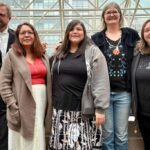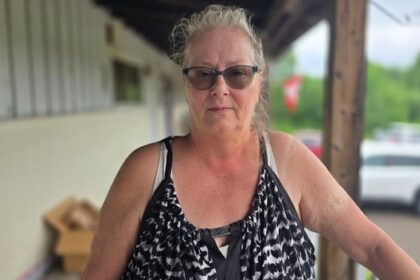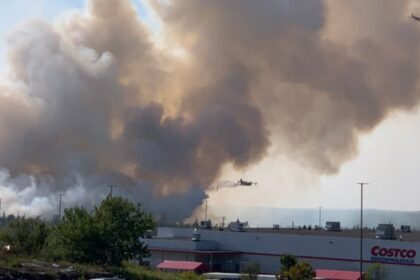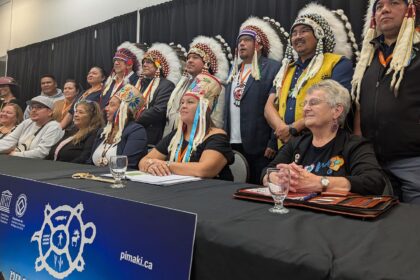An adult sc̓win (Okanagan sockeye salmon) swims alone in kɬúsx̌nítkʷ (Okanagan Lake) by a shoreline in kiʔláwnaʔ (Kelowna) in syilx Okanagan territory in November 2022. Due to settler-colonialism, any presence of salmon in the lake in the last 70 years has been rare, but efforts to create a waterway that would result in unimpeded salmon passage from sq’awsitkʷ (Okanagan River) into the lake will soon change that. Photo by Aaron Hemens More than 70 years after a dam blocked salmon from moving through their historic habitat, members of the syilx Okanagan Nation are celebrating the creation of a future fish passage. For decades, salmon haven’t been able to travel through sq’awsitkʷ (Okanagan River) into kɬúsx̌nítkʷ (Okanagan Lake). People gathered today in snpink’tn (Penticton) for a groundbreaking ceremony for a new fishway project — which began with a drum song by syilx Youth from Outma Sqilx’w Cultural School, followed by a welcoming from snpink’tn Indian Band Chief Greg Gabriel. “Welcome to today’s historic event — and I mean that in the sincerest and literal terms, what you are going to witness today,” he said. Gabriel thanked the Youth for starting the ceremony off “in a right way,” and said it warms his heart that they are witnessing the ground break for the site of the future fish passage. “You will see the salmon return to our lakes, as they did well before the 1900s — salmon that we lived with for thousands of years,” he said. caylx Richard Armstrong attended Friday’s ceremony, and was invited to help break ground at the future fish passage site. Armstrong has led salmon ceremonies across his nation since he was 14, as he was trained and tasked to do. He agreed that restoring the salmon’s ancient migration routes is historic. ‘A proud moment for us all’ caylx Richard Armstrong, fourth from the left, participates in the ceremonial ground breaking of a future fish passage for salmon travelling into kɬúsx̌nítkʷ (Okanagan Lake) past the Penticton-Okanagan Lake Dam in snpink’tn (Penticton) on March 7. Photo courtesy of Okanagan Nation Alliance “I will be happy to see my relative, salmon, swimming around the dam and up into the waters and lands that their great ancestors had access to,” the syilx Elder and knowledge-keeper said in a statement. “A proud moment for us all.” Opening the route is one of Okanagan Nation Alliance’s (ONA) many initiatives dedicated to kł cp̓əlk̓ stim̓ (to cause to come back) for wild salmon across the Okanagan watershed and upper Columbia River system. The project began in February and is expected to conclude in June. The passage is located between the river and the lake at the east side of the Penticton-Okanagan Lake Dam in snpink’tn, in syilx Okanagan territories. A naturalized fishway is being developed around the dam on its east side, which will consist of a series of shallow, fast moving sections and pools made with natural rock. The fishway will be its own separate structure, functioning independently from the dam. This means the dam itself will not be impacted, and will remain operational with its infrastructure uncompromised. Zoe Eyjolfson, a geomorphologist with the ONA, told IndigiNews that larger rocks in the fishway will help break up the water’s flow, enabling diverse hydraulic activity that will allow salmon to easily navigate the stream. “This project has an ecosystems approach, not just a salmon focus,” Eyjolfson said. “Allowing unimpeded access into Okanagan Lake now opens up the entire lake for salmon fry to rear and grow into smolts before they migrate out to the Pacific Ocean.” With an area of 350 square kilometres, entry to the lake will allow salmon greater access to different habitats in surrounding waterways, Eyjolfson said. “[Passage] not only allows access to the cool waters of Okanagan Lake, but also to the tributaries of Okanagan Lake where adult salmon go to spawn.” The naturally winding river was narrowed and straightened in the 1950s — an engineering effort known as channelization — to help settler-colonialism of the area by reducing floods. It was also in this era that the Penticton-Okanagan Lake Dam was built to regulate the lake’s water flow into the river. “That dam … destroyed a lot of fish habitat — salmon habitat,” Gabriel said. “It took our salmon away when it was built.” Such efforts, along with industrial agriculture and numerous dams constructed along the river’s route, have severely impacted salmon populations— from ntytyix (spring chinook), sk’lwist (summer chinook) to sc̓win (Okanagan sockeye salmon) — and their return journey from the ocean back to the Okanagan watershed. A satellite view of the Penticton-Okanagan Lake Dam in snpink’tn (Penticton), between sq’awsitkʷ (Okanagan River) and kɬúsx̌nítkʷ (Okanagan Lake). Photo courtesy Google Maps “Over the past 20-plus years, ONA has done a tremendous amount of work in efforts to put the river back and put the fish back,” said Eyjolfson. “This guidance — put the river back and put the fish back — came from the late Chief Albert Saddleman in the late 1990s when Okanagan salmon were on the brink of extinction.” ‘Important that our salmon relatives come back’ Elders, dignitaries, community members and leaders from throughout the nation also attended Friday’s ceremony, including Chief Clarence Louie of the Osoyoos Indian Band. Louie said the dams on the river, as part of colonization, had a negative effect on the fish species so vital to syilx people. “This is a very historic time,” said Louie, head of the First Nation’s Chief Executive Council. “Most people don’t realize that the Okanagan syilx people are salmon people. We always have been. “It’s very important that our salmon relatives come back to their homeland.” ntytyix (Chief salmon) has been an integral food source and vital cultural icon for the syilx Okanagan Nation for thousands of years. Central to many of the nation’s captikʷł (syilx oral teachings and principles), ntytyix is one of the Four Food Chiefs who helped determine how the people-to-be would live, and what they would eat. “The first non-Native people that came here to this area, they wouldn’t have survived if it wasn’t for the salmon nation,” said Louie. “That’s what the non-Native people have to remember — your ancestors needed the salmon nation, just like our people.” It has been extremely rare to find any salmon in the 135-kilometre-long kɬúsx̌nítkʷ — and when it happens, the nation celebrates each occasion. Last September, ONA welcomed the “big milestone” of the first lone adult Okanagan summer chinook salmon successfully making its way home to kɬúsx̌nítkw from the ocean in many decades. In 2022, IndigiNews observed an adult sockeye salmon swimming alone in kɬúsx̌nítkʷ by a shoreline in kiʔláwnaʔ (Kelowna). The salmon passage project received $5 million funding and is a collaboration between multiple organizations and agencies — including the ONA, snpink’tn Indian Band, the City of Penticton, and provincial and federal governments. Several non-profit groups and foundations have also lent their support. “Together, we have brought the salmon back — our hard work, our prayers, and our ceremonies,” Armstrong said.
Monday, 22 Sep 2025
Canada – The Illusion
Search
Have an existing account?
Sign In
© 2022 Foxiz News Network. Ruby Design Company. All Rights Reserved.











